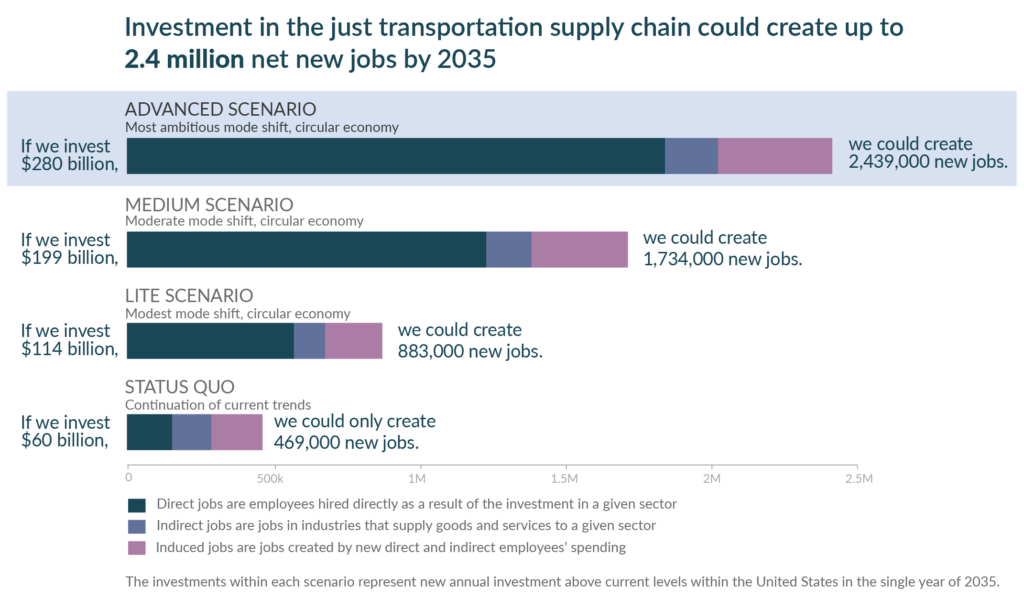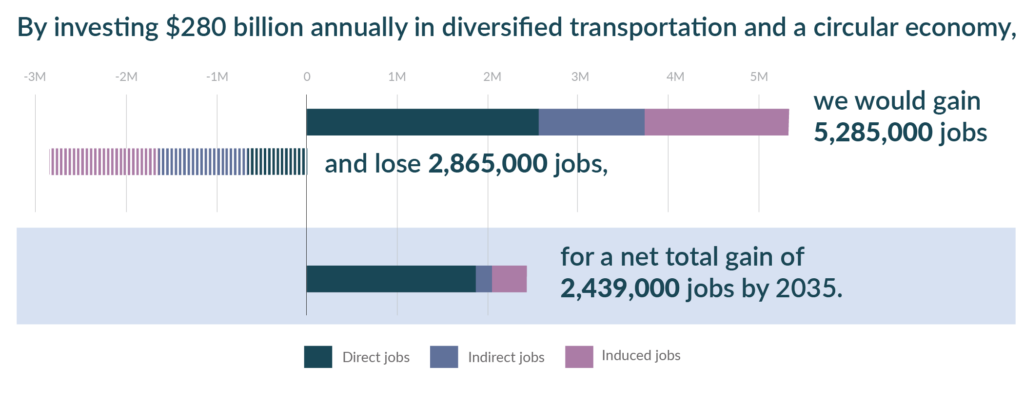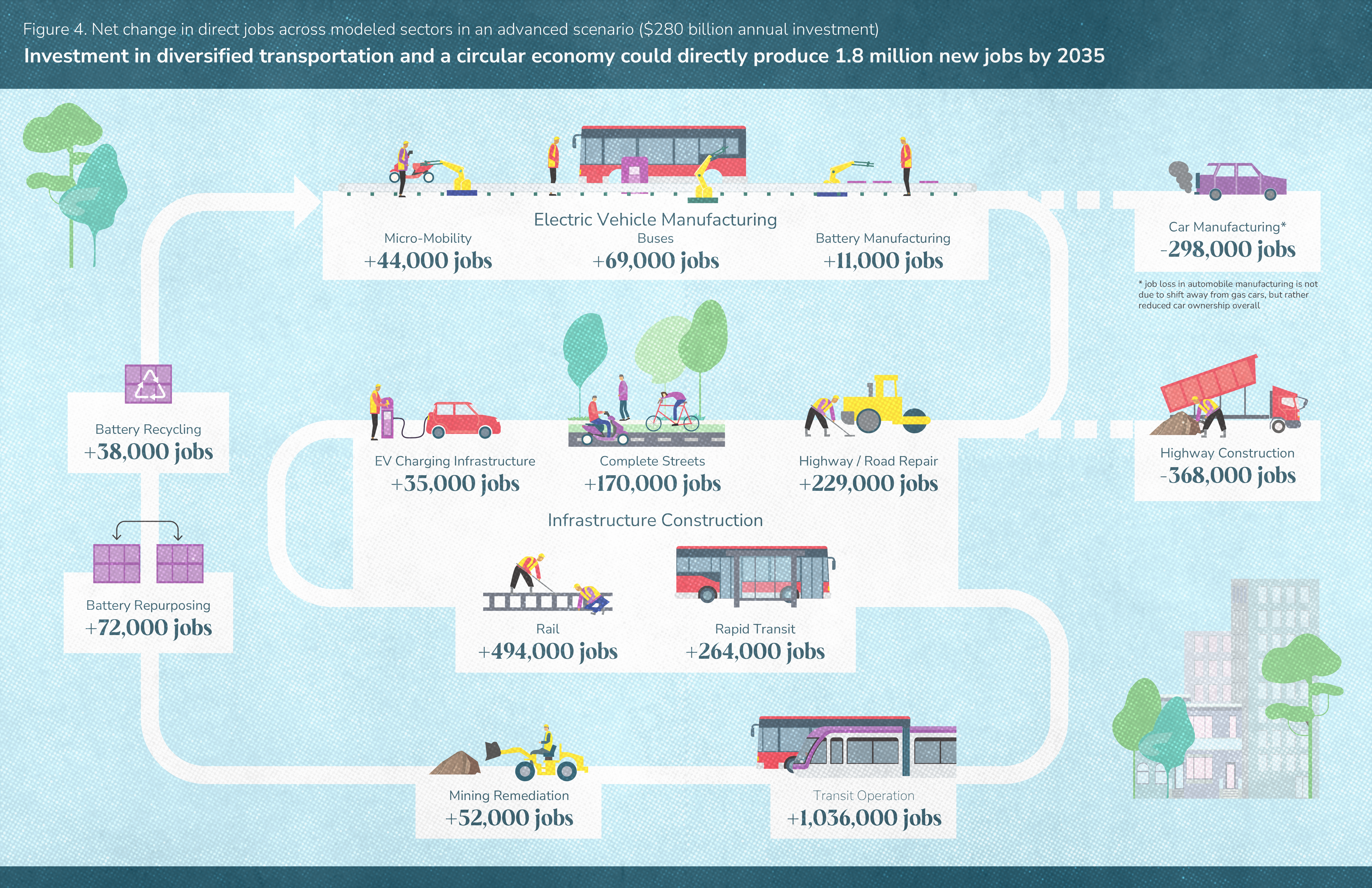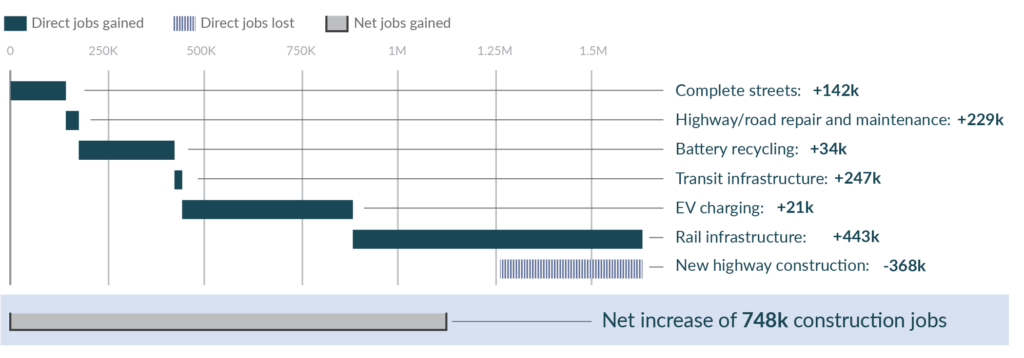Jobs for More Mining and Less Mobility
Modeling employment impacts from investment scenarios for transportation supply chain justice
The urgency of eliminating emissions from the transportation sector–the number one source of U.S. carbon emissions–intensifies with every day of inaction. Some climate advocates believe that decarbonization hinges on quickly electrifying all remaining gas-powered vehicles in a burgeoning electric vehicle market.
In contrast, this report reveals the broad benefits of a diversified, pro-worker, and pro-community transportation system. Such an approach will not only reduce emissions faster, provide more mobility for more people, and lessen the burden of mineral extraction for batteries–but also stimulate millions of new, dignified jobs across the supply chain.
We present three scenarios that assume progressively increased investment into sectors that diversify transportation options, improve working conditions, and reduce energy transition mineral demand. These scenarios build on the findings of our 2023 report, Achieving Zero Emissions with More Mobility and Less Mining. Each scenario that we explore–advanced, medium, lite, and status quo–corresponds to a distinct supply chain investment strategy in the year 2035, and outlines potential job impacts.
We find that an expansion of mobility options–including mass transit and safe streets–will produce a net increase of 2.4 million jobs

Under an “advanced” investment scenario, in which we invest $280 billion annually in diversified transportation and a circular economy, we find a net total of more than 1.8 million new direct jobs and 2.4 million new total jobs by 2035. The status quo scenario, in which we don’t shift our investment priorities, results in fewer than 150,000 new direct jobs—less than 10 percent of the jobs created in the advanced investment scenario.
Shifting to a decarbonized transportation system will require building entirely new supply chains, mitigating job losses that occur in industries currently dependent on fossil fuels, and correcting practices that have discriminated against marginalized people or leave them behind.
In terms of the transportation sector, this means thinking beyond simply swapping every single gas-powered vehicle for an electric one. By moving away from private passenger vehicles and investing in diversified transportation, we could:
- more quickly and efficiently eliminate US emissions;
- create millions of dignified jobs across the supply chain;
- reduce the demand for energy transition mineral extraction, which threatens water and biological resources and endangers frontline mining communities;
- address a host of deep structural problems within the current US transportation system: health and safety impacts from car accidents; economic losses from expensive fuel and insurance prices; and wasted space in towns and cities due to prioritization of land for parking and roads;
- account for those who either do not drive or do not own a vehicle, increasing their access to good jobs, housing, healthcare, education, recreation, and other basic needs.
By investing $280 billion annually in diversified transportation and a circular economy, we would gain 5,285,000 jobs and lose 2,865,000 jobs, for a net total gain of 2,439,000 jobs by 2035

Of the net jobs gained, 1.8 million would be direct and spread across the transportation sector

Under the advanced scenario, public transit operations employment would increase by more than 200 percent compared to current employment. These unionized jobs would be spread across every state in the country.
Highway construction jobs would be more than replaced by construction jobs spurred by investment in transit and rail infrastructure, highway and road repair, and roads designed to provide safe access for everyone, from pedestrians to motorists.
The advanced scenario results in a net gain of more than 740,000 total construction jobs

Under the current business model and ownership structure, the auto industry is likely to see a loss of employment in the scenarios considered, where private car sales are reduced. However, with a different business model—or even new ownership structures altogether—and greater worker control, auto companies could direct more revenue toward reducing work hours, increasing workers’ pay, and retaining and hiring more workers during the transition. In the advanced scenario, the manufacturing gains from other types of vehicle manufacturing amount to 87 percent of the lost auto manufacturing jobs. A shift from a standard 40-hour work week to a 32-hour work week with no loss in pay could further mitigate job loss within the auto sector. When these additional auto jobs are combined with new manufacturing jobs in other sectors, the modeling shows an almost neutral impact on overall manufacturing jobs in the advanced scenario.
In an advanced investment scenario, auto manufacturing jobs could be mitigated by the auto sector switching to a 32-hour work week.
The US faces a critical juncture. It can choose the status quo–a transportation network dominated by sprawling roads and large, private vehicles that perpetuate enormous mineral consumption and an underclass of people who do not drive or own a car. Or it can make intentional policy investments into a transportation system that slashes carbon, democratizes mobility, protects workers, reduces harmful extractive mining worldwide, and yields maximum economic benefits and job creation for everyone.
Taken together, these investments represent a once-in-a-generation opportunity for a zero-emissions transportation system which simultaneously improves the fate of the environment and communities while creating millions of good jobs to help workers transition into the green economy.


